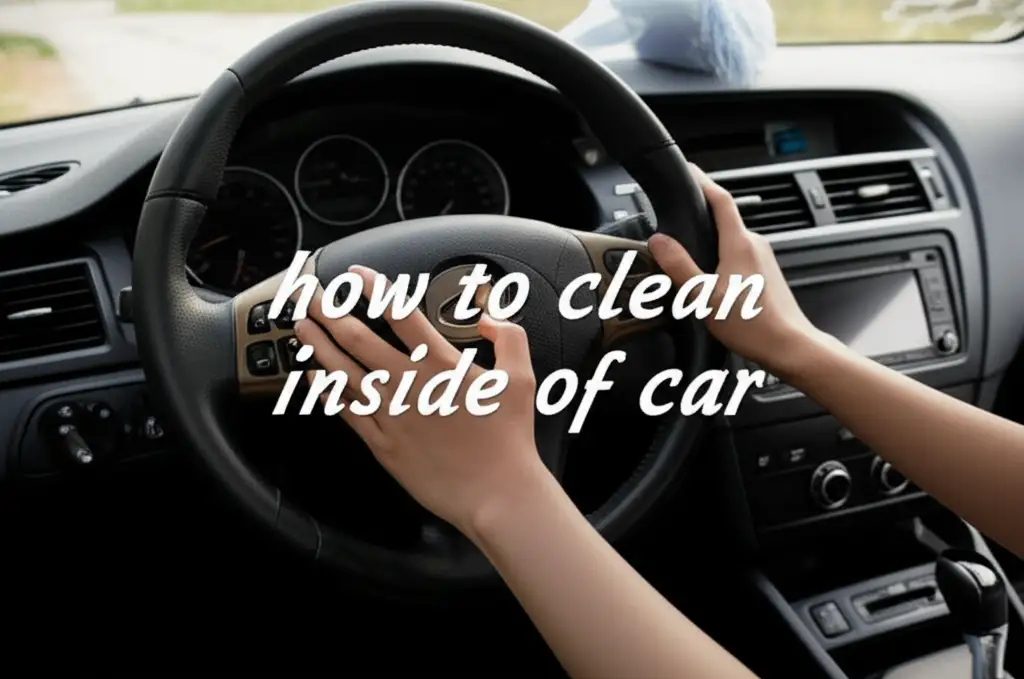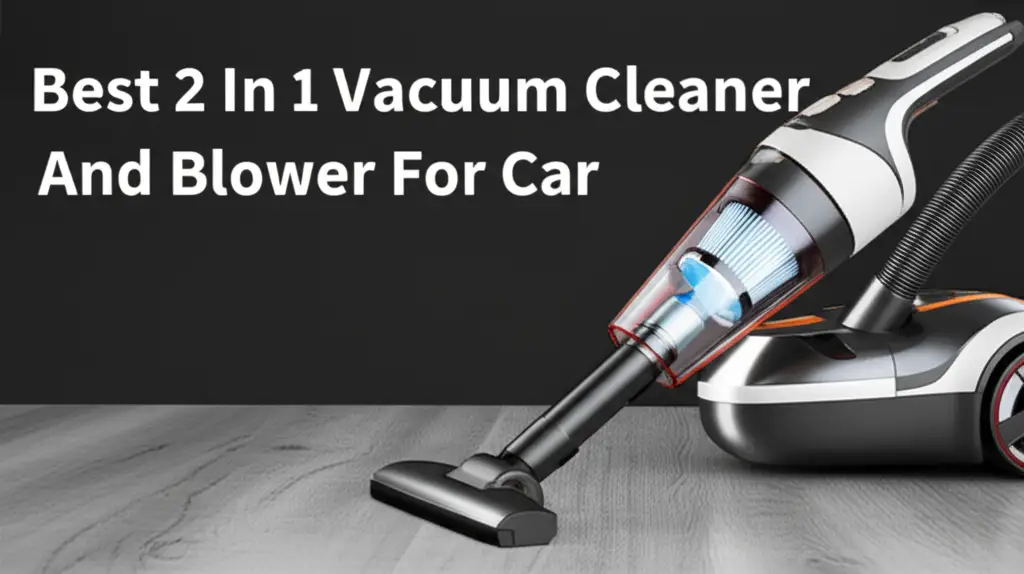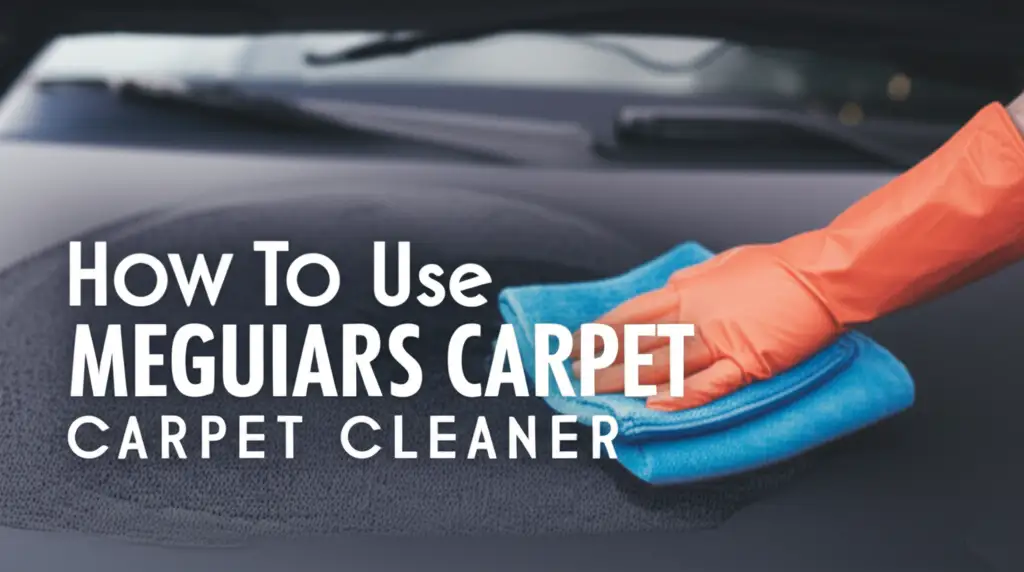· Elira Thomsen · Car Care · 16 min read
how to clean inside of car

Transform Your Ride: How to Clean Inside of Your Car
Is your car’s interior looking a bit tired? Do you wish for that fresh-car feel again? Cleaning the inside of your car seems like a big task. It is often put off for another day. However, a clean car interior makes every drive more pleasant. It also helps maintain your vehicle’s value. You do not need to be a professional detailer to achieve great results.
This guide will show you simple, effective steps to clean inside of your car. We will cover everything from vacuuming floors to shining the dashboard. You will learn about the right tools and products to use. We will also discuss how to tackle tough stains and bad smells. My goal is to make car cleaning easy and rewarding for you. Get ready to enjoy a pristine vehicle interior.
Takeaway:
- Gather essential tools like a vacuum, microfibers, and appropriate cleaners before starting.
- Work from top to bottom, removing loose debris first and then cleaning surfaces.
- Treat different materials, like fabric, leather, and plastic, with specific care products.
- Address stains promptly and use proper techniques to avoid damage.
- Finish with glass cleaning and odor elimination for a truly fresh interior.
Cleaning the inside of your car involves a methodical approach. First, remove all loose items and trash. Next, vacuum the floors and seats thoroughly. After that, wipe down all surfaces using appropriate cleaners. Finally, clean the windows and treat any odors to restore freshness.
Prepare for Success: Essential Supplies for Car Interior Cleaning
Getting started with car interior cleaning requires the right tools. You need proper equipment to do a good job. Having everything ready before you begin saves time. It also makes the cleaning process much easier. I always make a checklist of items.
Your basic toolkit should include a reliable vacuum. This vacuum needs good suction. It also needs various attachments. These attachments help reach tight spots. You will also need specific cleaning solutions for different surfaces. Do not forget a collection of clean cloths and brushes.
Vacuum Cleaners and Attachments
A good vacuum is your best friend for car cleaning. Handheld vacuums work well for quick clean-ups. A shop-vac offers more power for deep cleaning. Look for models with a narrow crevice tool. This tool gets into tight spaces, like between seats. A brush attachment helps agitate dirt on carpets and upholstery. This lifts dirt for easier removal.
Consider a small car-specific vacuum if you clean often. These vacuums are portable. They also have attachments designed for vehicle interiors. Using the right attachment makes vacuuming very efficient. This step is key to removing most loose dirt and crumbs. Always empty the vacuum often for best performance.
Cleaning Solutions and Protectants
Different car surfaces need different cleaners. You need an all-purpose interior cleaner for general wiping. This cleaner works on most plastics and vinyl. For upholstery, use a fabric cleaner or a dedicated carpet shampoo. Leather surfaces require a specialized leather cleaner and conditioner. This keeps the leather soft and prevents cracks.
Glass cleaner is essential for windows and mirrors. Make sure it is ammonia-free. Ammonia can damage tinted windows. Protectants are also important. Use a UV protectant on dashboards. This prevents cracking and fading from sun exposure. Always test new products in a small, hidden area first.
Brushes, Cloths, and Applicators
Microfiber cloths are excellent for car interior cleaning. They are soft, absorbent, and lint-free. Use several cloths: one for cleaning, one for drying, and one for polishing. A detailing brush helps clean air vents and crevices. A soft-bristled brush can agitate carpet dirt.
Applicator pads are useful for applying protectants evenly. For very tough stains, a stiffer brush might be needed. Ensure all cloths and brushes are clean. Dirty tools can spread grime or scratch surfaces. Keeping your tools clean makes your car cleaner.
Start with the Basics: Clearing Debris and Dust
Before any deep cleaning, you must remove all loose items and dust. This first step saves you a lot of effort later. It prevents wet dirt from becoming muddy stains. I always start by decluttering the car. This makes the workspace clear.
Remove all trash, papers, bottles, and old food wrappers. Take out floor mats. Empty ashtrays and door pockets. Gather personal items like chargers and sunglasses. Put them in a bag or box. This prepares the car for the real cleaning.
First Pass Vacuuming
Once everything is out, begin vacuuming. Use a powerful vacuum cleaner. Start from the top, working your way down. Vacuum the headliner lightly if it is dusty. Then, move to the seats. Use the proper attachment for seats. Go over them multiple times.
Next, vacuum the car carpets. Pay extra attention to high-traffic areas. These areas collect the most dirt. Use the crevice tool to get under the seats. Vacuum all corners and edges. Do not forget the trunk area. A thorough vacuuming makes the next steps much easier. For more insights into what your car’s carpet is made of and how it affects cleaning, you can read what is car carpet made of.
Air Vents and Crevices
Air vents collect a surprising amount of dust. Use a detailing brush or a small paintbrush to clean them. Gently brush the dust out. Then, use your vacuum’s crevice tool to suck up the dislodged dust. A cotton swab can reach tiny areas.
Door panels have many nooks and crannies. Use the crevice tool there too. Clean around seat rails and console edges. Compressed air can also help blow dust out of hard-to-reach spots. This step helps remove hidden dirt.
Wiping Down Surfaces
After vacuuming, wipe down all hard surfaces. Use an all-purpose interior cleaner. Spray it onto a microfiber cloth, not directly onto the surface. Wipe down the dashboard, door panels, and center console. Use a separate clean, dry cloth to buff.
For areas with caked-on dirt, let the cleaner sit for a moment. Then wipe it away. Always work in small sections. This ensures no cleaner dries before you wipe it off. This step removes surface grime and leaves a fresh look.
Deep Cleaning Car Seats and Upholstery
Car seats see a lot of use. They can collect dirt, spills, and stains. Cleaning them properly restores their appearance. The cleaning method depends on the seat material. Always identify the material first. This prevents damage.
Fabric, leather, and vinyl seats each need specific care. Using the wrong product can cause harm. My approach is always to be gentle. Test cleaners in an inconspicuous spot. This ensures the product is safe.
Identifying Seat Material
Most car seats are fabric, leather, or vinyl. Fabric seats feel soft and breathable. Leather seats are smooth and often have a distinct smell. Vinyl seats look similar to leather but feel more synthetic. Check your car’s manual if you are unsure. Knowing the material guides your choice of cleaner.
For fabric, a dedicated fabric cleaner is best. For leather, use a pH-neutral leather cleaner. Vinyl often responds well to an all-purpose interior cleaner. Never use harsh chemicals on any seat material. They can cause discoloration or cracking.
Stain Removal Techniques
Spills happen. Treat fresh stains immediately. Blot the stain with a clean cloth. Do not rub, as this can spread the stain. For fabric stains, spray the fabric cleaner directly on the stain. Let it sit for a few minutes. Then, gently agitate with a soft brush. Blot with a clean, damp cloth. Repeat until the stain is gone. For challenging stains like cheese, specific techniques are needed. Learn more about removing such stains by reading how to clean cheese out of carpet.
For leather stains, wipe with a damp cloth first. If the stain remains, use a small amount of leather cleaner on a microfiber cloth. Gently wipe the stain. Follow with a leather conditioner. This prevents the leather from drying out. Always work in small sections for all stain removal.
Drying and Protecting Fabric Seats
After cleaning fabric seats, ensure they dry completely. Open car doors and windows. Use a fan to speed up drying time. Damp seats can develop mildew and a bad smell. Avoid sitting on wet seats. This can transfer dirt back onto them.
Once dry, consider applying a fabric protectant. This spray creates a barrier. It helps repel future spills and stains. It makes subsequent cleanings easier. Apply the protectant evenly. Allow it to cure fully before using the seats. This step keeps your seats looking better for longer.
Tackling Car Carpets and Floor Mats
Car carpets and floor mats take the brunt of foot traffic. They collect dirt, mud, and debris. Regular cleaning keeps them fresh and prevents odors. Deep cleaning these areas makes a huge difference. I always prioritize these elements for a clean car feel.
My method involves a combination of vacuuming and spot treatment. Sometimes, a full shampoo is necessary. The goal is to remove embedded dirt. You also want to restore their color and texture.
Vacuuming and Beating Mats
Start by removing all floor mats from the car. Shake them out vigorously to dislodge loose dirt. For deeper embedded dirt, hang them up. Then, beat them with a rug beater or stick. This loosens stubborn particles. Afterward, vacuum both sides of the mats thoroughly. Use a brush attachment to agitate the fibers.
Inside the car, vacuum the carpets with great care. Use the narrow crevice tool to get into every corner. Pay attention to the areas under the pedals. These spots gather a lot of grime. A strong vacuum pulls out most of the dry dirt. This prepares the carpet for wet cleaning.
Spot Cleaning and Full Extraction
For small stains on carpets, use a carpet spot cleaner. Spray it directly onto the stain. Let it sit for a few minutes. Gently blot with a clean microfiber cloth. Do not rub the stain. Repeat until the stain lifts. For larger areas or heavily soiled carpets, a full extraction is best.
You can use a carpet extractor or a wet/dry vacuum with a carpet cleaning solution. Follow the product instructions carefully. Work in small sections. Spray the cleaner, agitate with a brush, then extract the dirty water. This lifts deep-seated grime. For general carpet cleaning tips, especially for items similar to floor mats, you can look into how to clean a rug by hand.
Drying Car Carpets Properly
After wet cleaning, proper drying is crucial. Damp carpets can lead to mold and mildew. This creates a musty odor. Open all car doors and windows. Use a fan to circulate air inside the car. A dehumidifier can also help pull moisture from the air.
If possible, let the car sit in direct sunlight. Sunlight helps dry and kill bacteria. Do not put floor mats back until they are completely dry. Ensure the car’s interior carpets are dry too. This step prevents future problems. Learn more about how to manage moisture under your car’s carpet by checking how to dry matting under a carpet in a car.
Shine Your Dashboard, Console, and Door Panels
These hard surfaces define your car’s interior appearance. They are often made of plastic, vinyl, or sometimes wood trim. Keeping them clean and protected makes a huge difference. Dirt and dust quickly accumulate on them. My approach focuses on gentle cleaning and protection.
You want them clean but not overly shiny or greasy. A matte or satin finish looks best. It also avoids distracting reflections. Proper care extends their life and maintains their look.
Gentle Wiping for Sensitive Surfaces
The dashboard is sensitive to harsh chemicals. Use an all-purpose interior cleaner. Spray it onto a clean microfiber cloth. Wipe the dashboard gently. Avoid spraying directly onto the dashboard. This prevents cleaner from getting into electronics. Wipe down the center console, door panels, and steering wheel.
Use a separate, clean, dry microfiber cloth to buff the surfaces. This removes any streaks or residue. For glossy finishes, a quick detailer spray can enhance the shine. Always use products specifically designed for automotive interiors.
Detail Brushing for Vents and Buttons
Air vents, button crevices, and textured surfaces collect dust. A soft detailing brush or a small paintbrush works well here. Gently brush out the dust. Follow with a vacuum cleaner to suck up the dislodged particles. A cotton swab can help clean very tight spaces.
Use a small amount of interior cleaner on a cotton swab for stubborn grime. Wipe around buttons and dials carefully. Be gentle with electronic screens. Use a screen-specific cleaner and a soft cloth for these. Do not press hard.
UV Protection and Finishing Touches
After cleaning, apply a UV protectant to the dashboard and other plastic surfaces. This protects them from sun damage. UV rays cause fading and cracking over time. A protectant also helps repel dust. It keeps surfaces looking new.
Apply the protectant with a microfiber applicator pad. Spread it evenly. Then, buff off any excess with a clean, dry cloth. This leaves a non-greasy, natural finish. This step is important for long-term interior health.
Crystal Clear Views: Cleaning Interior Glass and Mirrors
Clear windows are not just about looks. They are essential for safe driving. Streaky windows can reduce visibility. They also make the car feel less clean. Cleaning interior glass requires special attention. My goal is always a streak-free finish.
This step is often the last in a full interior detail. It provides a clean, crisp view. It makes a significant impact on the overall feel of the car.
Choosing the Right Glass Cleaner
Not all glass cleaners are suitable for car interiors. Avoid cleaners with ammonia. Ammonia can harm window tints. It can also damage vinyl and plastic surrounding the glass. Look for ammonia-free automotive glass cleaners. These are safe for all car glass.
You can also make a simple solution. Mix equal parts distilled water and white vinegar. This natural cleaner works well. It leaves no residue. Always use clean, lint-free microfiber cloths for glass cleaning.
Streak-Free Techniques
Spray the glass cleaner onto one section of the window. Do not overspray. Use two clean microfiber cloths. With the first cloth, wipe the cleaner across the glass in straight lines. Overlap your strokes. This lifts dirt and grime.
With the second, dry cloth, immediately buff the glass. Use circular motions or straight up-and-down strokes. This removes any streaks. Clean the inside of the windshield and back window from both sides for best results. Do the side windows and mirrors next. Finish with a final check from different angles to spot any missed spots.
Final Touches: Odor Removal and Maintenance Tips
A truly clean car smells fresh. Lingering odors can ruin the feeling of a clean interior. These smells often come from spills, food, or moisture. Addressing them is crucial. I focus on eliminating the source, not just masking the smell.
Once your car is spotless and smells great, maintaining it is key. Regular upkeep prevents dirt and odors from building up again. This saves you time in the long run.
Eliminating Lingering Smells
First, find the source of the odor. Check under seats and in storage compartments. Remove any old food, spills, or damp items. Clean the affected area thoroughly with an appropriate cleaner. For fabric or carpet, a carpet cleaner with enzymatic properties works well. It breaks down odor-causing organic matter.
For general odors, an odor eliminator spray can help. Do not just use air fresheners, which only mask smells. You can also place an open container of baking soda in the car overnight. Baking soda absorbs odors. For persistent smells, an ozone generator might be needed, but these require caution and proper ventilation.
Regular Maintenance Habits
Maintaining a clean car interior is easier than deep cleaning it every time. Create some simple habits.
- Regular Trash Removal: Empty your car of trash every time you fill up gas.
- Quick Vacuum: Give the interior a quick vacuum once a week or every two weeks. Focus on high-traffic areas.
- Wipe Down Surfaces: Keep a small pack of interior cleaning wipes in your glove box. Use them for quick wipe-downs of spills or dust.
- Shake Mats: Shake out floor mats regularly. This prevents dirt from embedding into the carpet.
- Address Spills Immediately: Clean up spills as soon as they happen. This prevents stains and odors.
These small actions add up. They keep your car interior looking and smelling fresh. This means fewer big cleaning jobs. A clean car is a happy car.
FAQ Section
Q1: How often should I clean the inside of my car? A1: Clean your car’s interior every 1-3 months for a deep clean. For daily upkeep, remove trash and wipe down surfaces weekly. Regular attention prevents dirt buildup. It also makes full cleanings easier and less frequent. This keeps your car looking good.
Q2: Can I use household cleaners on my car’s interior? A2: It is best to use cleaners made for car interiors. Household cleaners may contain harsh chemicals. These can damage car materials like plastic, vinyl, or leather. They can cause discoloration or cracking. Always test any cleaner in a hidden area first.
Q3: What’s the best way to clean car leather seats? A3: Use a pH-neutral leather cleaner. Apply it to a microfiber cloth, then wipe the seats gently. Do not use too much product. Follow with a leather conditioner. This keeps the leather soft and prevents drying. Avoid harsh scrubbing on leather.
Q4: How do I remove pet hair from car carpet? A4: Use a rubber glove or a squeegee. Rub it across the carpet. This creates friction and clumps the hair. Then, vacuum up the hair. A pet hair removal brush specifically designed for carpets also works well. Repeat until all hair is gone.
Q5: What should I do if my car smells musty after cleaning? A5: A musty smell often means dampness or mildew. Ensure all carpets and upholstery are completely dry. Use fans and open windows to air out the car. An odor eliminator spray or baking soda can absorb lingering smells. If the problem persists, check for leaks.
Q6: Is it safe to use a steam cleaner on car interiors? A6: Steam cleaners can be effective. Use them with caution. Do not use high heat or excessive moisture on sensitive materials like electronics or some plastics. Test in an hidden area first. Ensure good ventilation to allow surfaces to dry quickly.
Conclusion
Cleaning the inside of your car does not have to be a big chore. It is a rewarding process. Following these steps helps you achieve a truly clean and fresh interior. You start by preparing your tools. Then you remove debris and dust. After that, you clean seats, carpets, and hard surfaces. You finish with sparkling windows and a fresh scent.
A clean car makes every journey more enjoyable. It also protects your vehicle’s value. I encourage you to try these methods. See how much better your car feels. Regular maintenance will keep it looking its best. Start cleaning your car interior today. You will love the results.





